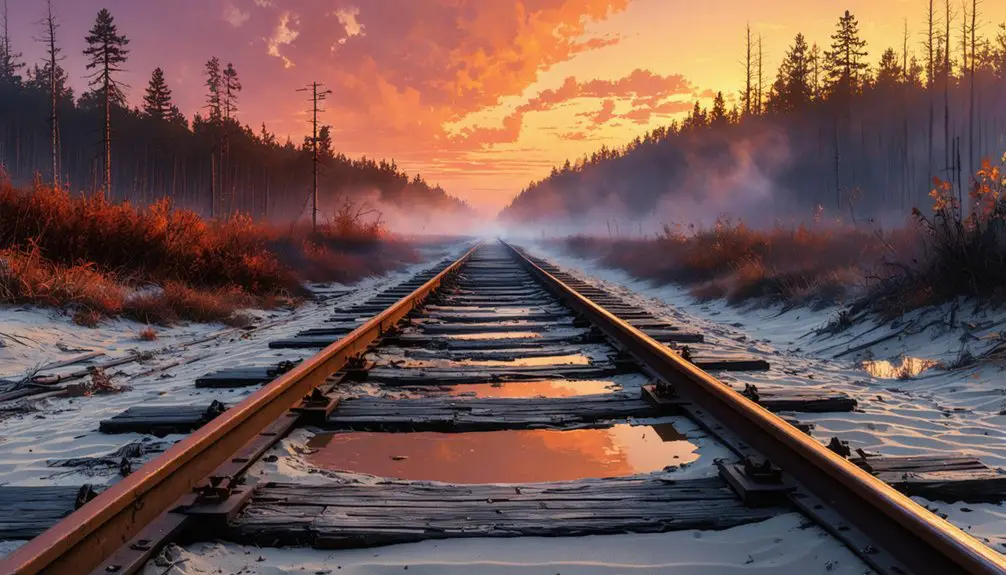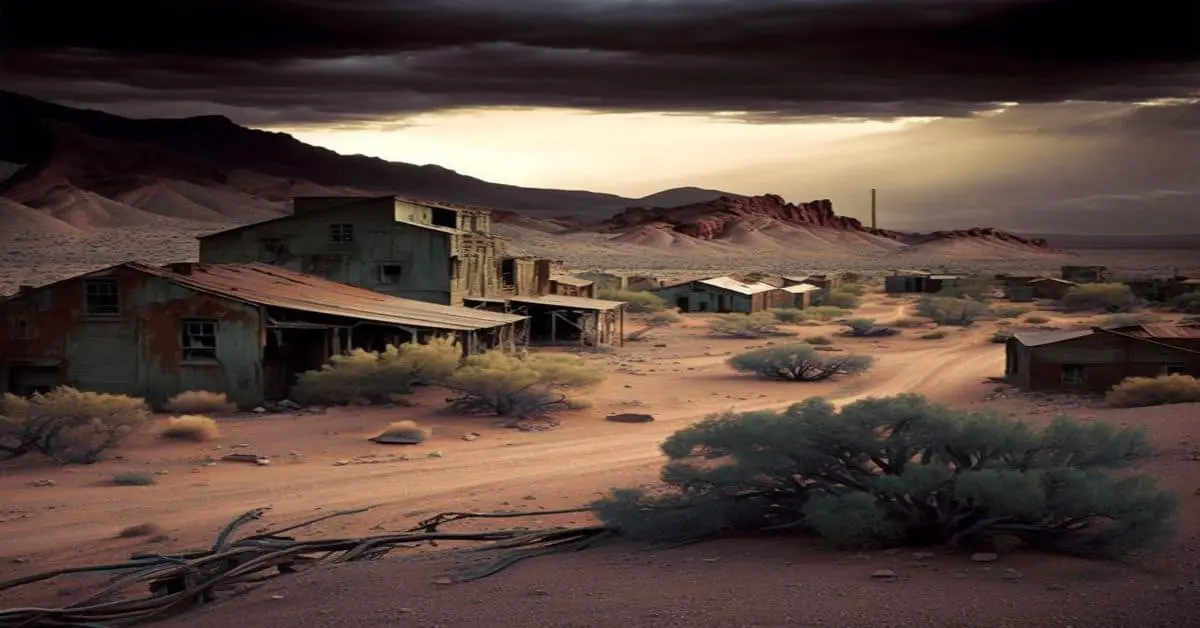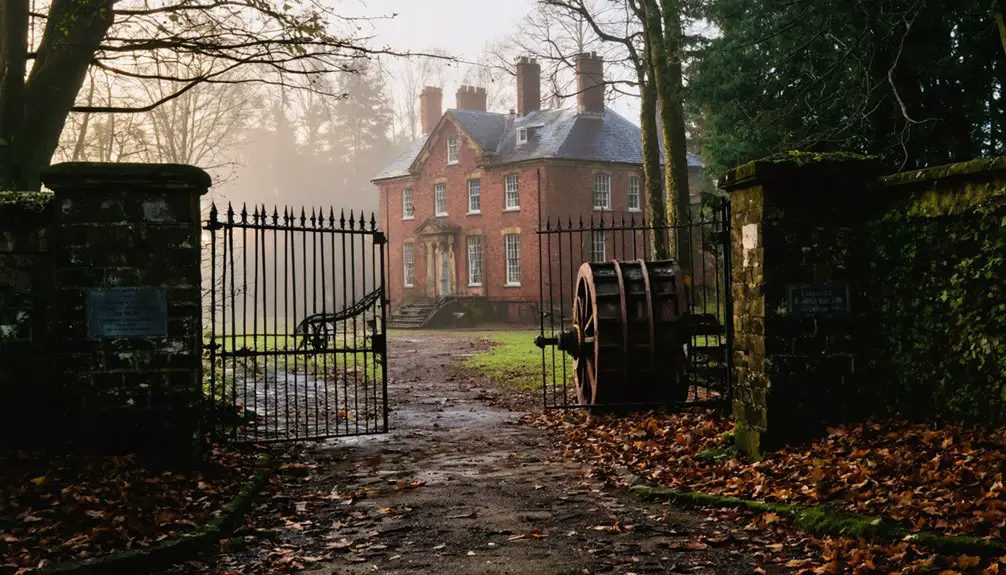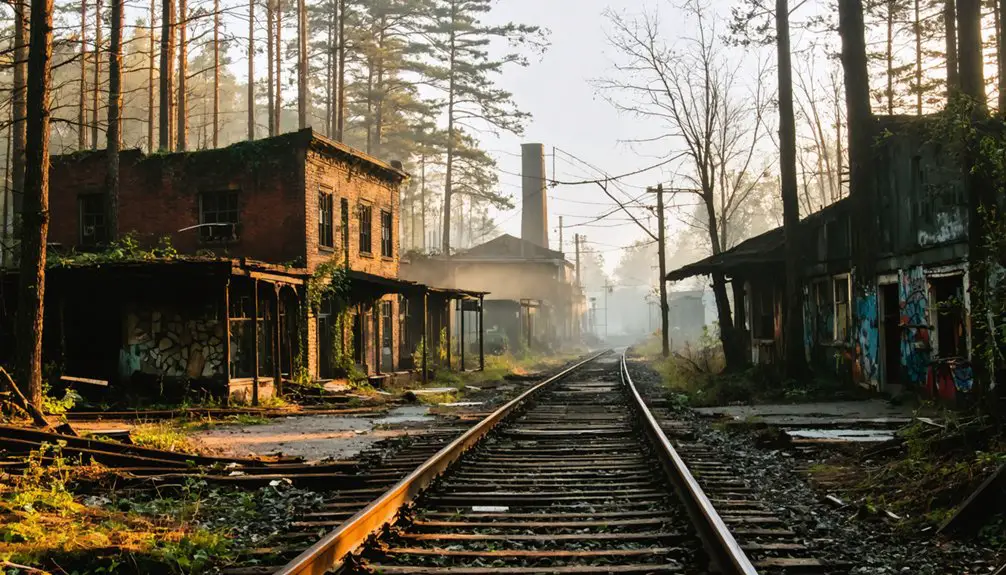You’ll find Double Trouble tucked away in Ocean County, New Jersey, a former lumber and cranberry company town named for its troublesome dam failures in the 1770s. This self-sufficient community thrived until the 1950s with its sawmill, cranberry bogs, worker housing, and general store. Now preserved as a 205-acre historic district within Double Trouble State Park, the ghost town’s eight miles of trails and historic buildings reveal fascinating stories of Pine Barrens industry and daily life.
Key Takeaways
- Double Trouble transformed from a thriving industrial village into a ghost town following economic decline in the 1950s and 1960s.
- The abandoned village features preserved historic buildings, including a sawmill, cranberry packing house, and worker housing.
- The site became a state park in 1964, with its historic district now listed on the National Register of Historic Places.
- Eight miles of trails allow visitors to explore the ghost town’s remnants and learn about early American industrial life.
- The community’s decline was triggered by market changes, Edward Crabbe’s death, and the Garden State Parkway’s construction.
The Legend Behind the Name
While many ghost towns earn their eerie names from tragic events, Double Trouble‘s moniker stems from a more practical source – the persistent dam failures that plagued Thomas Potter‘s sawmill in the 1770s. Heavy rains caused his earthen dam to fail twice in one season, leading Potter to coin the now-famous name.
Two competing folklore origins add depth to the story. One version credits Potter’s exasperation with the repeated dam collapses, while another highlights the ecological interactions between local wildlife and the dam’s structure. The village later became home to fresh dry harvested cranberries under Edward Crabbe’s leadership.
According to this second tale, beavers and muskrats would gnaw at the dam, causing workers to shout “Here’s trouble!” when discovering leaks. When they’d find two breaks simultaneously, the cry would escalate to “double trouble!” – a name that stuck and defined the village’s identity. Today, visitors to Double Trouble State Park can explore the historic village while experiencing its unique blend of natural beauty and local history.
A Self-Sufficient Pine Barrens Community
You’ll find that Double Trouble’s self-sufficiency stemmed from its well-organized infrastructure, which included worker housing, a general store, and facilities to support both lumber and cranberry operations.
The village sustained itself through a mix of year-round residents and seasonal workers, who arrived each autumn for the cranberry harvest and could purchase essentials at the company store. Historic trails now wind through the preserved industrial landscape, offering visitors glimpses into early American industry.
The community’s success relied on this careful balance of permanent and temporary labor, with the village providing all necessary amenities to support both the workers and the thriving industrial operations. The site was eventually acquired in 1964 by New Jersey, ensuring its preservation as a state park.
Worker Housing and Amenities
Located deep within New Jersey’s Pine Barrens, Double Trouble Village operated as a remarkably self-sufficient company town that provided extensive housing and amenities for its workforce.
Worker accommodations ranged from pickers’ cottages to a communal bunkhouse, with a separate foreman’s residence overseeing the operation. This thriving settlement supported cranberry production operations from the 1860s onward. The village was acquired and preserved by the state in 1964 to maintain its historical significance.
You’ll find the village was designed for complete self-reliance, featuring:
- A general store stocking daily necessities
- A cook house providing meals for the labor force
- Shower facilities maintaining worker hygiene
- A one-room schoolhouse serving resident families
The communal facilities were strategically placed along service roads connecting the housing to the cranberry bogs and sawmill, creating an efficient layout that supported both daily life and industrial operations within this isolated Pine Barrens settlement.
Local Industry and Commerce
Deep within the Pine Barrens, Double Trouble Village thrived as a remarkable example of industrial symbiosis between lumber and cranberry production.
You’ll find an indication of self-sufficiency in the village’s dual economic engines: a water-powered sawmill dating to 1765 and expansive cranberry bogs that emerged in the 1860s after timber clearing created ideal growing conditions.
The Double Trouble Company, formed in 1909, masterfully orchestrated lumber production and cranberry economics through an integrated system of facilities.
The Company Foreman resided in a house built in 1900, where the overseer of operations managed both the cranberry harvests and lumber production.
You can trace the village’s commercial soul through its preserved infrastructure – from the sawmill that processed Atlantic white cedar to the cranberry packing houses that prepared harvests for market.
The general store anchored local commerce, while the company shipped both lumber and cranberries to broader markets until 1964.
Today, visitors can explore the restored ghost town while enjoying scenic hiking trails through the surrounding wilderness.
Community Support Systems
Through intricate networks of mutual support, Double Trouble Village maintained remarkable self-sufficiency despite the challenging Pine Barrens environment. The community’s resilience emerged from strong interpersonal bonds and shared resources that sustained village life through seasonal changes and economic fluctuations. They adapted well to the environment’s unique characteristics, drawing clean water from the tea-colored streams that flowed through their land.
You’ll find the village’s mutual support systems reflected in:
- Family-based labor sharing during cranberry harvests
- Communal packing houses where villagers sorted and processed crops together
- Shared educational experiences where elders passed down essential survival skills
- Resource exchange networks that guaranteed everyone’s basic needs were met
These support structures weren’t just practical – they formed the backbone of Double Trouble’s social fabric. The village frequently recruited Italian immigrant workers from Philadelphia during harvest seasons, integrating them into their communal support system.
Rise and Fall of the Double Trouble Company
You’ll find Edward Crabbe’s vision for Double Trouble took shape in 1909 when he formally established the Double Trouble Company, expanding operations to 260 acres of cranberry bogs while modernizing the sawmill and packing facilities.
His company grew into one of the East Coast’s largest cranberry producers, supporting a self-sufficient industrial community with worker housing, a general store, and a schoolhouse.
The company’s fortunes declined after Crabbe’s death, ultimately dissolving in 1964 as market forces and industry changes brought an end to this unique Pine Barrens enterprise.
Crabbe’s Corporate Empire Expands
Edward Crabbe’s entrepreneurial vision took shape in 1909 when he founded the Double Trouble Company, transforming a rural New Jersey settlement into a thriving corporate enterprise.
Crabbe’s influence expanded rapidly through smart economic strategies that capitalized on the region’s natural abundance.
You’ll discover how he built his empire through:
- Leveraging existing sawmills powered by Cedar Creek to establish lumber operations
- Converting cleared wetlands into productive cranberry bogs
- Developing a self-sufficient company town with complete infrastructure
- Marketing diverse products including lumber, blueberries, and cranberries
The company’s growth made it one of New Jersey’s largest cranberry operations, with Double Trouble controlling everything from timber harvesting to fruit processing.
Under Crabbe’s leadership, this vertically integrated operation dominated regional agriculture and commerce for decades.
Market Forces Signal Decline
Despite its decades of dominance in New Jersey agriculture, the Double Trouble Company faced mounting challenges by the 1950s that would ultimately lead to its dissolution.
The death of Edward Crabbe in 1953 created a devastating leadership void, while market fluctuations drove cranberry prices down and slashed company profits.
You’d have witnessed the company’s struggles intensify as the Garden State Parkway cut through their eastern tract in 1954, fragmenting valuable farmland.
The shift from dry to wet harvesting methods reduced the need for migrant workers, leaving the worker cottages abandoned.
When the American Cranberry Exchange dissolved in 1957, you could see the writing on the wall – Double Trouble had lost its vital market channel, accelerating its decline toward eventual sale to the state in 1964.
Historic Buildings and Village Layout
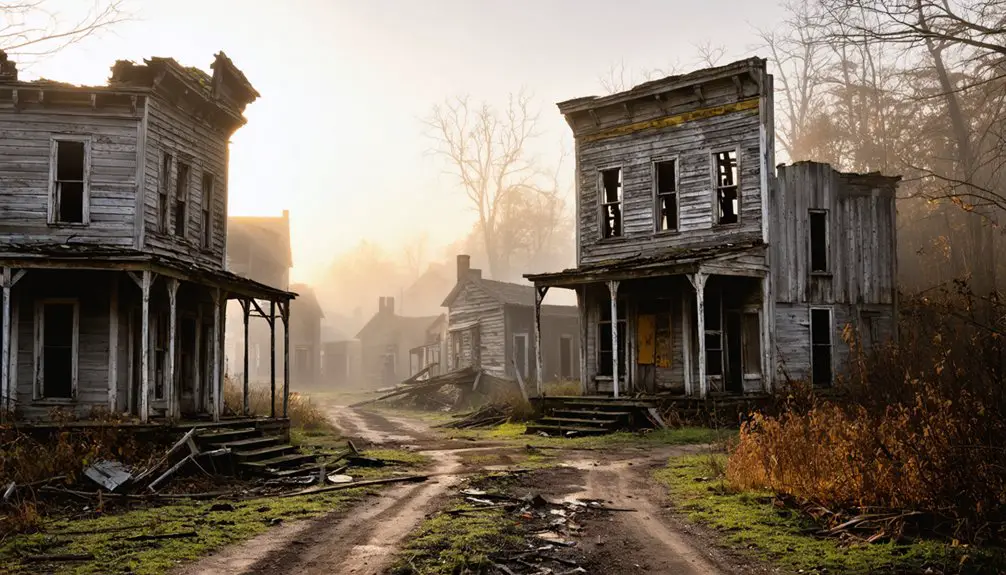
While many ghost towns fade into obscurity, Double Trouble Village stands as a remarkably preserved 200-acre settlement that showcases the region’s industrial heritage.
You’ll find the historic architecture perfectly arranged for maximum industrial efficiency, with the sawmill and cranberry packing house serving as central hubs of activity.
The village layout reveals four distinct features that defined life in this self-contained community:
- A restored sawmill housing authentic 18th and 19th-century lumber equipment
- Workers’ residences strategically positioned near industrial buildings
- Essential community structures including a schoolhouse and general store
- A network of service roads connecting to marked trails through former bog areas
The buildings, constructed primarily of local Atlantic white cedar, exemplify the practical, utilitarian design typical of Pine Barrens company towns.
From Lumber Mills to Cranberry Fields
The transformation of Double Trouble Village from a lumber powerhouse to a cranberry empire began in the 1860s, marking a pivotal shift in New Jersey’s Pine Barrens industry.
You can trace the lumber legacy through the extensive cutting of Atlantic white cedar along Cedar Creek, where water-powered sawmills once dominated the landscape.
Nature itself paved the way for change. As timber clearing created wetland bogs, you’ll find these conditions perfectly suited the cultivation of native cranberries.
The Double Trouble Company seized this opportunity, becoming one of New Jersey’s largest cranberry producers by the early 1900s. They built packing houses, developed irrigation systems, and established worker housing to support the growing operation.
The company’s success demonstrates how the region’s industrial focus evolved, adapting to changing economic demands while utilizing the land’s natural resources.
Life in a Company Town
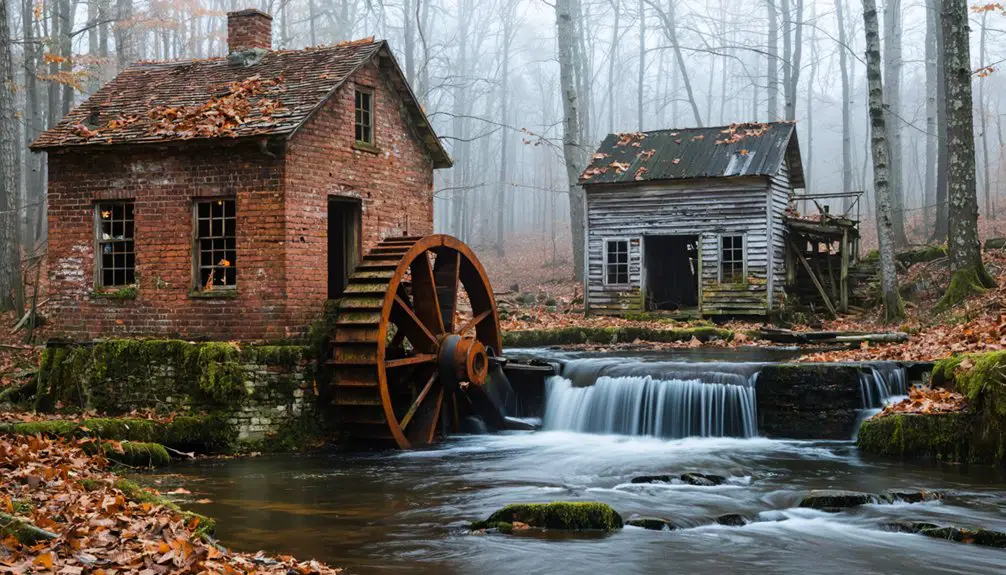
Life at Double Trouble Village centered around the company’s tight control of both work and living spaces, mirroring the structure of company towns across America.
You’d find your daily existence shaped by the lumber company’s oversight, from where you lived to how you spent your wages.
The extent of company control manifested in:
- Required residence in company-owned housing near the mills
- Dependence on company-provided services and infrastructure
- Limited economic mobility due to controlled wages
- Social activities centered around company-sanctioned events
While labor disputes were common in many company towns, Double Trouble’s workforce remained relatively stable.
You’d work alongside fellow laborers, sharing similar living conditions and facing the same challenges under the watchful eye of management, creating a close-knit but carefully monitored community.
Preservation as a State Park
Since its designation as a New Jersey State Park in 1964, Double Trouble Village has transformed from a bustling company town into a carefully preserved historic district spanning 8,666 acres.
You’ll find the park’s historic preservation efforts focused on protecting both natural and cultural treasures. The 205-acre historic district, listed on the National Register of Historic Places, maintains original structures including the sawmill, cranberry packing house, schoolhouse, and worker cottages.
While exploring the grounds, you can experience the cultural significance of 19th and early 20th-century industry through restored buildings containing authentic equipment. The surrounding Pine Barrens ecosystem flourishes with cedar forests, swamps, and the pristine Cedar Creek.
Eight miles of trails let you discover this unique landscape while protecting sensitive environments, and interpretive programs reveal the rich heritage of this remarkable site.
Exploring the Mystery Spot
Deep within Double Trouble State Park lies an enigmatic clearing that has puzzled visitors and paranormal researchers for decades.
If you’re ready to explore this mysterious spot, you’ll find it about half a mile past the Garden State Parkway, accessible via well-maintained hiking trails.
Here’s what makes this location truly extraordinary:
- Trees lie inexplicably flattened against the ground, creating a distinct circular pattern.
- Electronic devices frequently malfunction, with batteries draining unexpectedly.
- Strange lights have prompted FAA investigations of possible plane crashes.
- Atmospheric anomalies create unique sensory experiences for visitors.
You won’t pay an entrance fee to investigate these mysterious phenomena yourself.
While there aren’t specific signs marking the Mystery Spot, you’ll find it nestled within the park’s historic landscape, where paranormal enthusiasts and curious hikers regularly venture to discover its secrets.
Natural Heritage and Modern Tourism
While many ghost towns fade into obscurity, Double Trouble Village thrives as a unique preservation site where nature and history intersect.
You’ll discover a rare glimpse into the Pine Barrens ecosystem, where Atlantic white cedar forests and wetland habitats showcase the area’s ecological significance. The 205-acre historic district preserves both natural wonders and cultural heritage, allowing you to explore the dynamic relationship between industry and environment.
Today’s tourism impact centers on education and outdoor recreation. You can walk marked trails past historic cranberry bogs, visit the restored sawmill that once processed local cedar, and explore the preserved company town buildings.
This living classroom demonstrates how the lumber and cranberry industries shaped both the landscape and local economy while protecting these resources for future generations.
Frequently Asked Questions
What Was the Average Worker’s Salary at Double Trouble During Peak Operations?
You’d have earned between $0.15-$0.50 per hour during historical wages peak, with higher rates for sawmill work compared to seasonal cranberry production, though exact records aren’t fully documented.
Are Overnight Camping or Paranormal Investigations Allowed Within the Historic Village?
Like a locked door at sunset, you’ll find camping regulations prohibit overnight stays and ghost tours within the village. You can’t conduct paranormal investigations either – it’s strictly daytime visits only.
How Many Workers Lived in Double Trouble During Its Busiest Period?
While exact worker demographics weren’t recorded, you’d likely have found dozens to a few hundred laborers living there during busiest operations, typical of Pine Barrens company towns in that era.
What Native American Tribes Originally Inhabited the Double Trouble Area?
You’ll find the Lenape tribal influence was dominant in this region, as these Native Americans, also known as Delaware Indians, were the primary indigenous people who stewarded these lands.
When Was the Last Commercial Cranberry Harvest at Double Trouble?
You’ll find the last commercial cranberry harvest, using traditional wet-harvest techniques on native and cultivated varieties, took place around 2010 when the final farmers retired from their operations.
References
- https://www.nj.gov/dep/parksandforests/historic/doubletrouble.html
- https://www.nj.gov/dep/parksandforests/historic/Double Trouble Historic Village- A Window Into Pinelands Industries 2020.pdf
- https://vocal.media/horror/why-bayville-nj-is-a-stephen-king-town
- https://www.jerseyshoreonline.com/berkeley/double-trouble-celebrates-60-years-as-state-park/
- https://theopenroadahead.com/2020/09/07/double-trouble/
- https://www.sitesofnj.com/New_Jersey/Ocean_County/Double_Trouble_Village/Double_Trouble_Village.html
- https://nj.gov/dep/parksandforests/historic/docs/double trouble_web.pdf
- https://patch.com/new-jersey/berkeley-nj/double-trouble-celebrates-60-years-state-park
- https://www.journeythroughjersey.com/sites/double-trouble-village-state-historic-site/
- https://rngr.net/publications/tpn/63-2/double-trouble-historic-village-a-window-into-pinelands-industries
